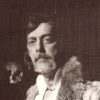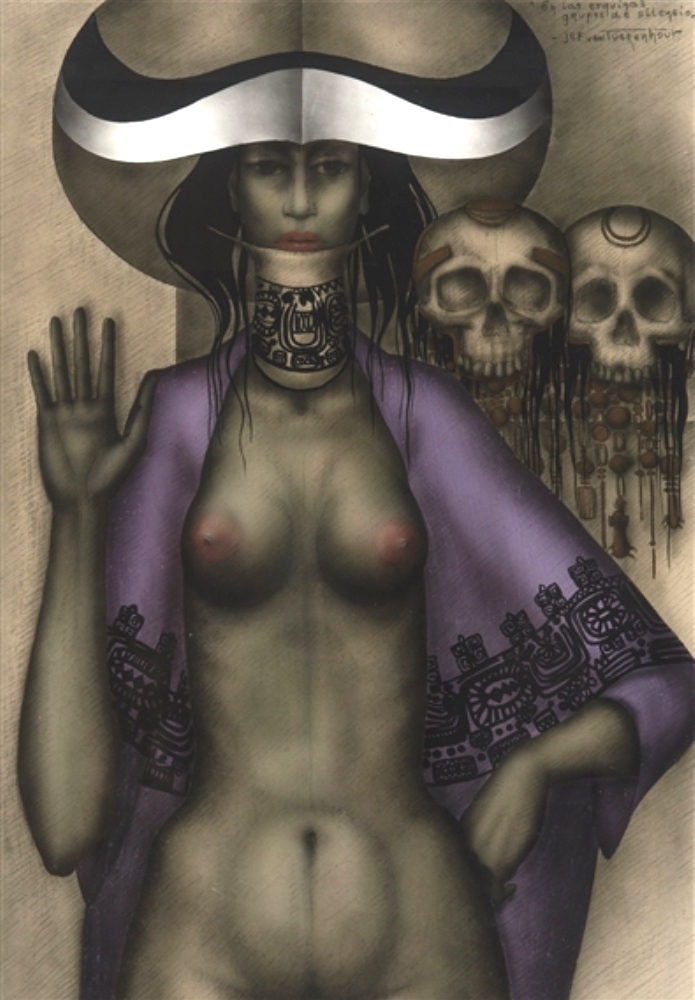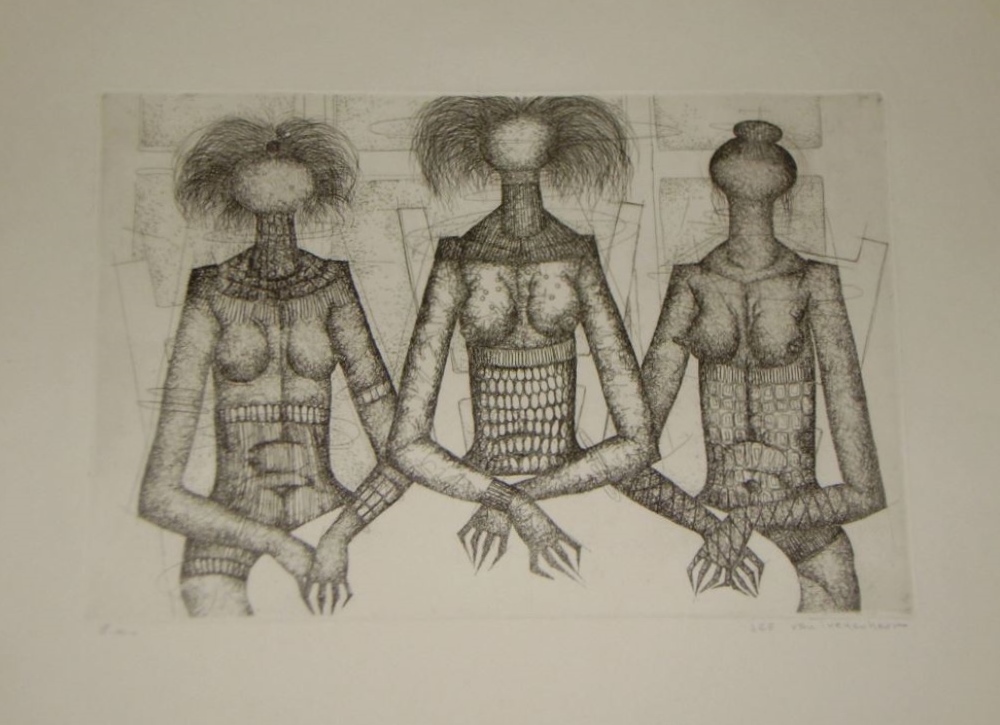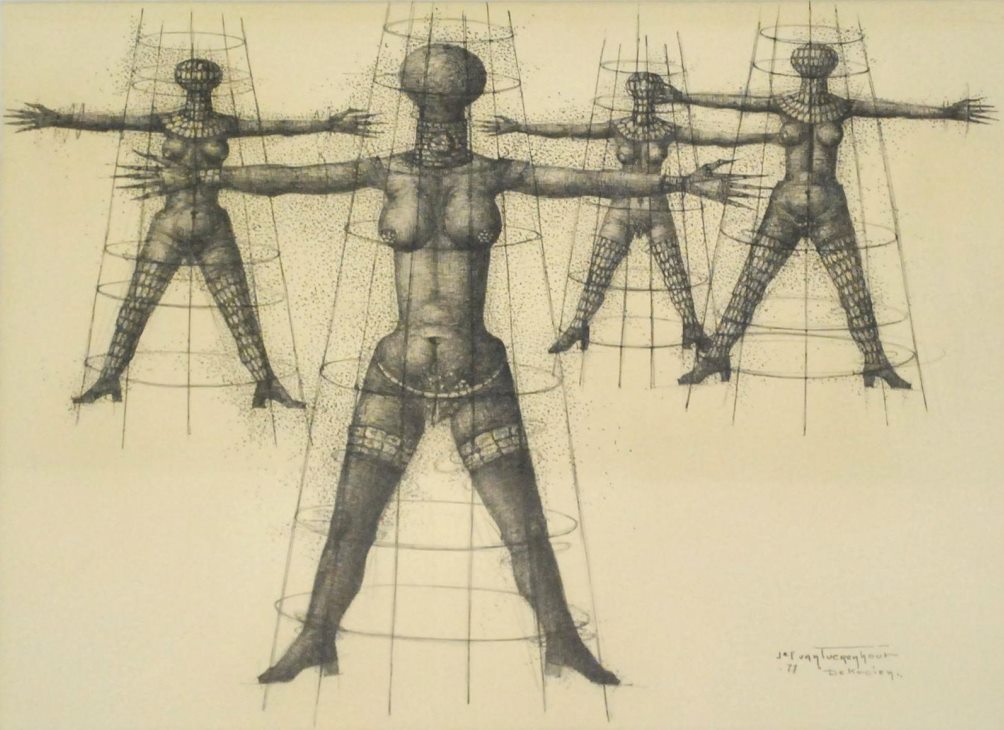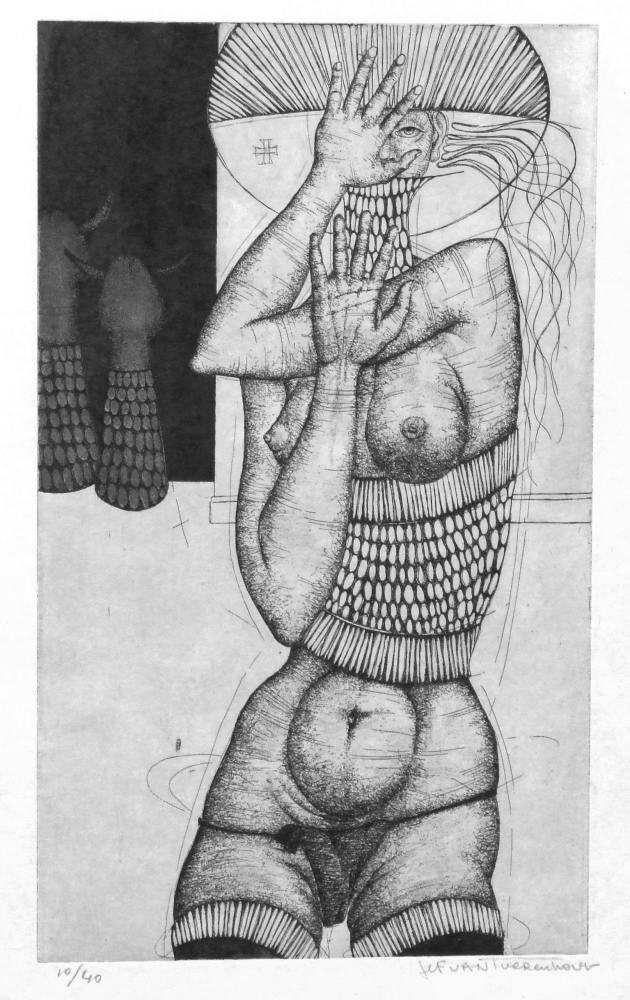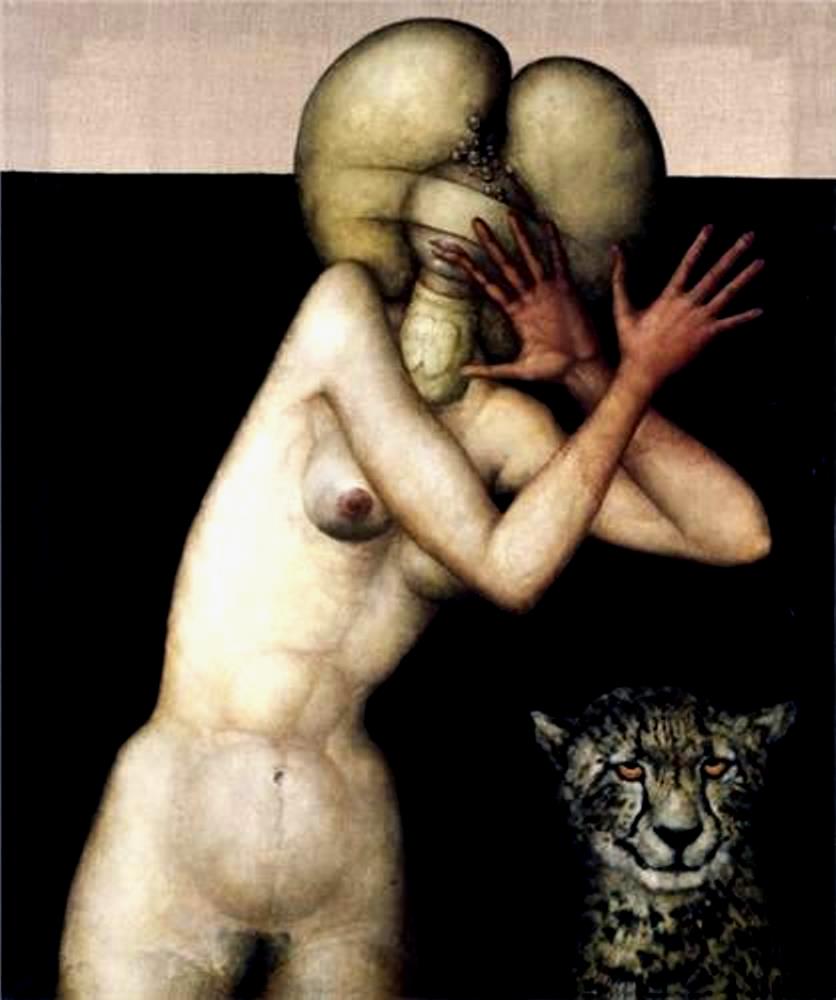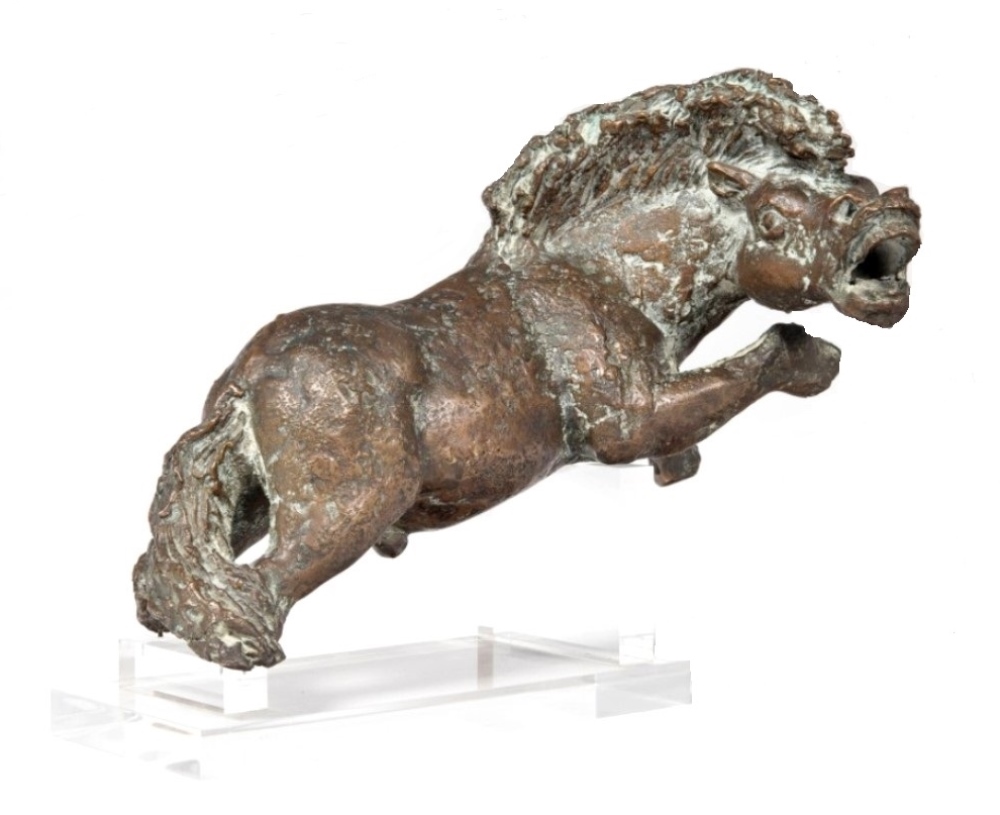Jef van Tuerenhout born in Mechelen, on May 23, 1926 and died in Wenduine, on March 4, 2006; he was a Belgian painter, sculptor, ceramist, engraver and jewellery designer. Throughout his career his style evolved from bitter miserabilism, to Flemish expressionism and neo-expressionism. Finally, this evolution led to a slightly erotic, sensual style half way border surrealism and magic realism. He is also sometimes called the last Belgian surrealist.
Jef van Tuerenhout spent his childhood in Mechelen, Belgium. He studied painting and sculpture at the Academy of St Luke’s in Brussels during World War II. He was awarded the honorific price from the St Luke Academy. Although that year only two artists became professional painters: himself and Armand Minner. He himself admitted that he had learned in fact little or nothing at the academy and barely knew the difference between using turpentine or white spirit.
From the start he resolutely opted for the profession of an artist painter as teaching at an academy, he considered a waste of time. He wanted, as a young individualist; at that point exclude commercial compromises. During this period he painted expressionistic work with many gray color variations, reminiscent of the work of Constant Permeke. They depict a compacted and closed mental world, darkened by war experiences and laced with a gloomy anxiety.
His first more commercial works he signed with the pseudonym “Jan van Gent”. It involved different subjects, such as seasides, dunes of the Belgian coast, Spanish streets, bulls and gypsies, and even holly Mary’s.
As a young artist he could quickly work himself loose from the Flemish expressionist grasp. Abstraction could not further appeal to him; he found this style to be regional and limited him to a previous revolved period.
He chooses figurative painting and make it his own recognizable style and imagery. First he worked from a model, but discarded that soon, because he obtained a central figure with a background, the composition of that method bothered him.
In 1949 he already participated in the group exhibition “Contemporary art in Belgium”, along with several other painters also seeking an innovative, modern and contemporary art to create. Pol Mara, Paul van Hoeydonck, Jan Cox and Gaston Bertrand where part of those artists, and together with Jan Vaerten, Rudolf Meerbergen and Jan Cox, he worked at the magazine (Tijd en mens) “Time and People” (1949-1955), led by Jan Walravens (1920-1965) as the theorist of ‘’de tijd’’ (Time) and Mens-generatie (Humankind-generation). He also, already in 1950 had his first solo exhibition in Mechelen and in 1951 he showed several works in the exhibition, organized by “Time and Man”. (Tijd en Mens).
He moved to Antwerp in 1952 and lived in attics, wandering from house to house. He was commissioned a monumental mural by the (Boom Metal works) “Boomse metaalwerken” a company that closed its doors in 1998.
By pure chance he came to live in Ostend and when he camped in Bredene in 1954, he met by chance again a friend who was on the move. He could take over his workshop in Ostend. There Van Tuerenhout started immediately a small art gallery. Later he moved to a big Belle époque house on the sea promenade (Dijk) of Ostend. In this house he and his wife, Clara Raes, spend most of their lives.
He then unavoidably came in contact with the anarchistic art world of Ostend, centered around the night owls and bohemians in that same city, gathering in the pub “La Chèvre Folle” Etienne Elias, Yves Rhayé, Willy Bosschem, Roland Devolder, Hubert Minnebo, Lismonde, and blues guitarist Roland to name a few.
He has also held several exhibitions in the pub and sold works. In 1967 he held there, along with a German artist, an event directed against the Berlin Wall. A police intervention was even necessary to calm down their spirits.
He took part in 1955 in the group exhibition “Ensor, Permeke, Spilliaert and contemporary painting” in Ostend. From that moment on exhibitions followed one after the other, both domestically and abroad. In 1957, two paintings were bought by the collection Quaker Storage Co. of Philadelphia (USA). He exhibited for the first time etchings and sculptures at the exhibition in Brussels in 1966. His first lithograph was published in 1969.
In 1966 his style definitely evolved and he left the miserabilistic expressionist style.
He created a new, meticulously detailed world, with an enchanting but domineering woman as muse. He would now almost exclusively concentrate on the representation of the mystical in a woman, represented with an exotic, sophisticated and complex coloration, bathed in light and darkness, in a sensual, magical realist style.
Just as Paul Delvaux and Félix Labisse, he slowly created his own female archetype that returned up again and again in his work: dignified, unapproachable, irresistible, enigmatic, intriguing, attractive, sophisticated and sensual. From then on al evolved within that sensual beacon increasingly perfectionistic and with a fine sense of color harmony. His partially nude female figures, he portrays mostly stretched out in a conscious way with lean, elongated hands. He himself calls it “verticalism”. They also often carry an iron tube kind of neckless around the neck and majestic hats. Also, these elements contribute to the vertical lines of the figure.
His first anthropomorphic creatures were half sphinx half Sibyl and are still with influences of Flemish expressionism. These creatures live in a silent, petrified world surrounded by an atmosphere of sultry sensuality.
His paintings and graphics were full of suppressed eroticism. They contain all sorts of magical characters, and fetishistic attributes. Like the egg = fertility, bird = freedom; skeletons = duality of life and death, or the animally of cats, tigers or large raptors. Inspired by African, Asian and Polynesian sculptures, he gave his archetype the appearance of those primitive sculptures: tall, impregnable priestesses with elongated necks and oval faces, exotic hairstyles, covered with eagle heads, horns or colorful halos. His works also gave his fascination with felines again, panthers and lions (he even had for a while a lion and leopard as pets), whose movements are as smooth and graceful as his women.
All this gave an individual style to his work, which at a glance, made them immediately recognizable to everyone. He often gave his work a nod and an eye wink to other artists by using elements from their work: the monstrous heads of Yves Rhayé (1936-1995), (as in his work “The Lure managers”) or the flower hat of James Ensor (such as in his famous work “Hello James,” made in protest against the theft of the self-portrait of James Ensor) or again with James Ensor “the Entry of Jef van Tuerenhout in Ostend” to mark the Ensor year 1985.
He was also a creator and designer of jewellery in gold, silver and diamonds. He gave his first exhibition of jewelry in 1971. The O.R.T.F. (French television) in 1971 and the BRT (Flemish television) in 1972 made a TV portrait of him. In 1976; R. Claeys made the film “Portrait of Jef van Tuerenhout”.
He got in his long artistic career several times a retrospective starting in 1974 at the Casino, of Ostend, in 1975, 1986 and 2001 at the Cultural Center Antoon Spinoy, Mechelen, in the Italian artists town of Pietrasanta, near Pisa in 2005, on March 2006 at the Cultural Center in Aarschot, and summer 2006 in Blankenberge. In the last decades of his life he received extensive international recognition.
In all his foreign exhibitions he regularly came in contact with well-known artists, many of which he had among his personal friends: Salvador Dalí, Corneille, Karel Appel, César, Max Ernst, Fuchs, Paul Delvaux; but also with many famous singers and movie stars: Jacques Brel, Maurice Chevalier, Michèle Morgan.
He was appointed in 1976 Knight of the Order of Leopold II. He was also an ambassador for UNICEF. The proceeds of his painting and income for the poster of the Memorial Van Damme was given in 2003 to a project in Morocco.
He moved to Wenduine in 1993 in a quiet renovated old convent, where Soeur Sourire ever lived.
He died of a lingering illness on March 4, 2006 at his residence in Wenduine.
His works are mostly still in private collections, but also in museums at home and abroad. He was an individualist, an isolated figure and it can be difficult to classify him in one or other art movement or style. For this he reminds the same problem for classifying Leonor Fini and Fernando Botero.
#biography
Translated from Wikipedia Flemish to English by Yoannick Ysebaert #curator
